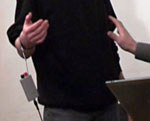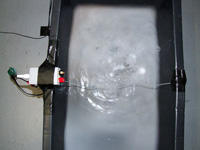 Theremin Sensors are based on the same principle as a well known electronic musical instrument the Theremin (theremin-vox) invented by Russian inventor Leon Theremin in 1919. The Theremin was the first electronic musical instrument furnished with special antennas, to control sound by free movement of hands in the space surrounding it.
Theremin Sensors are based on the same principle as a well known electronic musical instrument the Theremin (theremin-vox) invented by Russian inventor Leon Theremin in 1919. The Theremin was the first electronic musical instrument furnished with special antennas, to control sound by free movement of hands in the space surrounding it.
 The Terpsitone, built by Leon Theremin in 1932, was a variation on the Theremin – instead of an antenna for the hand it uses an antenna-platform to control sound by means of body movement. It was one of the first known motion tracking systems.
The Terpsitone, built by Leon Theremin in 1932, was a variation on the Theremin – instead of an antenna for the hand it uses an antenna-platform to control sound by means of body movement. It was one of the first known motion tracking systems.
What is the difference between the theremin-vox and the theremin-sensor?
- theremin-vox is a musical instrument, which produces musical sound;
- theremin-sensor is a controller. It produces control data to play with computer software.
 Unlike any classical theremin, t-sensor is convenient in case you need to analyse motion of the dancers or performers on stage or to work with distant sensitive objects in an interactive installation.
Unlike any classical theremin, t-sensor is convenient in case you need to analyse motion of the dancers or performers on stage or to work with distant sensitive objects in an interactive installation.
Analog t-sensors (1998) are based on classical theremin heterodyning principle and specialy developed sensitive circuitry.
They produce audio output with a pitch related to distance between the body and antenna. With a computer one can mesure velocity of changes (body movement near antenna, air flow, water drops near antenna etc.), direction of motion, changes in motion, periodicity of changes etc.
 The sensor box and receiver are separated and connected to each other with a long cable. All controls are built in a receiver, normaly located near the operator's computer. Main advantage - NO NEED IN TUNING ON STAGE.
Any adjustment can be realized by operator even during performance, which is very important for any interactive audio/video installations and live performance situation.
The sensor box and receiver are separated and connected to each other with a long cable. All controls are built in a receiver, normaly located near the operator's computer. Main advantage - NO NEED IN TUNING ON STAGE.
Any adjustment can be realized by operator even during performance, which is very important for any interactive audio/video installations and live performance situation.
 Digital USB d-sensors, are based on alternative direct-control principle.
Unlike any classical theremin designs and previous analog t-sensors, they have one main advantage - NO ANALOG TUNUNG IS NEEDED AT ALL!
After any change of hardware
Digital USB d-sensors, are based on alternative direct-control principle.
Unlike any classical theremin designs and previous analog t-sensors, they have one main advantage - NO ANALOG TUNUNG IS NEEDED AT ALL!
After any change of hardware  configuration system produces self adaptation and tuning by software means. No need in screwdriver to fight with coils! Just plug and play. Any conductive media could be connected to d-sensor as an antenna: metal objects, foil, water, human body, plants and vegetables, metal threads, thin plastic films with metallization, all sorts of Christmas stuff, conductive fabrics and clothes to monitor variations of electrical capacitances of different conductive medias, air flows, mechanical vibrations, etc.
configuration system produces self adaptation and tuning by software means. No need in screwdriver to fight with coils! Just plug and play. Any conductive media could be connected to d-sensor as an antenna: metal objects, foil, water, human body, plants and vegetables, metal threads, thin plastic films with metallization, all sorts of Christmas stuff, conductive fabrics and clothes to monitor variations of electrical capacitances of different conductive medias, air flows, mechanical vibrations, etc.
D-sensors are ideal for live interactive performance and long term interactive  audio/video installations to avoid any need in continuous maintenance by the personal.
audio/video installations to avoid any need in continuous maintenance by the personal.
Multichannel d-sensor systems are also available.
 The basic analog t-sensor system includes a sensor connected to the interface with a long shielded cable. It produces the frequency modulated output signal with a carrier frequency about 10 khz.
The basic analog t-sensor system includes a sensor connected to the interface with a long shielded cable. It produces the frequency modulated output signal with a carrier frequency about 10 khz.
To build a cheapest theremin-sensor system as a sort of compromice, one can connect the interface directly to the audio input of the sound card of the computer to work with a special MAX/MSP or PD patches. Among disadvantages of this solution are: dependency on quality of the sound card;
more processor power needed; audio inputs are occupied.
To make a complete digital USB multichannel sensor system we use an extra microcontroller. In this case the system can be powered from USB plug of the computer or any separate power adapter.
 Theremin Sensors are based on the same principle as a well known electronic musical instrument
Theremin Sensors are based on the same principle as a well known electronic musical instrument

 The sensor box and receiver are separated and connected to each other with a long cable. All controls are built in a receiver, normaly located near the operator's computer. Main advantage - NO NEED IN TUNING ON STAGE.
Any adjustment can be realized by operator even during performance, which is very important for any interactive audio/video installations and live performance situation.
The sensor box and receiver are separated and connected to each other with a long cable. All controls are built in a receiver, normaly located near the operator's computer. Main advantage - NO NEED IN TUNING ON STAGE.
Any adjustment can be realized by operator even during performance, which is very important for any interactive audio/video installations and live performance situation.  Digital USB d-sensors, are based on alternative direct-control principle.
Unlike any classical theremin designs and previous analog t-sensors, they have one main advantage - NO ANALOG TUNUNG IS NEEDED AT ALL!
After any change of hardware
Digital USB d-sensors, are based on alternative direct-control principle.
Unlike any classical theremin designs and previous analog t-sensors, they have one main advantage - NO ANALOG TUNUNG IS NEEDED AT ALL!
After any change of hardware  configuration system produces self adaptation and tuning by software means. No need in screwdriver to fight with coils! Just plug and play. Any conductive media could be connected to d-sensor as an antenna: metal objects, foil, water, human body, plants and vegetables, metal threads, thin plastic films with metallization, all sorts of Christmas stuff, conductive fabrics and clothes to monitor variations of electrical capacitances of different conductive medias, air flows, mechanical vibrations, etc.
configuration system produces self adaptation and tuning by software means. No need in screwdriver to fight with coils! Just plug and play. Any conductive media could be connected to d-sensor as an antenna: metal objects, foil, water, human body, plants and vegetables, metal threads, thin plastic films with metallization, all sorts of Christmas stuff, conductive fabrics and clothes to monitor variations of electrical capacitances of different conductive medias, air flows, mechanical vibrations, etc.  audio/video installations to avoid any need in continuous maintenance by the personal.
audio/video installations to avoid any need in continuous maintenance by the personal.  The basic analog t-sensor system includes a sensor connected to the interface with a long shielded cable. It produces the frequency modulated output signal with a carrier frequency about 10 khz.
The basic analog t-sensor system includes a sensor connected to the interface with a long shielded cable. It produces the frequency modulated output signal with a carrier frequency about 10 khz.